
TM 5-822-9/AFM 88-6, Chap.10
tolerated. Because of the relatively thin layers of
courses necessary, the use of internal spud-type
vibrators to properly consolidate the mixtures is
difficult. The use of a mechanical plate, screed, and
float or float vibrators has proven satisfactory. In
many instances, because of dimensional and shape
restrictions, consolidation by hand tampers will be
necessary.
(4) In the final finishing operations, the surface
shall not be left slick due to excess epoxy resin
bleeding to the top. Fine aggregate can be
broadcast on top of slick areas before the epoxy
resin hardens to improve the surface texture. The
final surface should be left even with the sur-
rounding pavement. Excess mortar or binder should
be removed since featheredge finishing usually will
form a weak bond resulting in chipping under
traffic.
Figure 3. Placement of joint filler sheet to maintain active crack
(5) The formed joint should be sealed in the
through area to be patched.
conventional manner as specified in Joint Depart-
ments of the Army and Air Force TM 5-822-
7/AFM 88-6, Chapter 8, and Air Force AFM 88-6,
Chapter 7. This work can usually be initiated about
24 hours after epoxy resin concrete or mortar
placement unless low temperatures have
appreciably retarded the hardening of the epoxy
resin binder.
16. Procedure for condition 6. Repair of the
type of failure in condition 6 (fig 1) involves
remedial measures to stop progression of the longi-
tudinal crack in both directions. The procedure for
this is similar to the repair of spalled areas. The full
length of the crack should be routed with a rotary-
Figure 4. Finishing a patch containing an active crack.
grooving tool after the pavement surface is
carefully examined to locate the ends of the crack.
(2) The general procedure for batching the
Since the crack termination points may be almost
epoxy resin concrete or mortar is outlined in
indiscernible, sandblasting and high-pressure air jets
paragraphs 10 and 11. The size of the batch to be
should be used near the apparent ends to remove
prepared at one time will vary with the area to be
fines embedded in the crevices. Also, laitance
repaired. In cases where the depth of the area being
beyond the apparent ends should be removed by
repaired is greater than 2 inches, a multiple-course
sandblasting to make identification of the actual
procedure will be followed. It has been found that
ends of the crack more accurate. Core holes, 4 to 6
the heat buildup in courses thicker than 2 inches
inches in diameter should be drilled at each end of
sometimes is sufficient to cause cracking. The
placement of an additional course or courses, if
the crack. These core holes should be centered on
required, should be delayed until the peak
the ends of the crack to assure complete crack
temperature has been reached and the temperature
removal. After removal of the core, all residual
of the previously placed material is decreasing. In
fines on the core hole wall should be removed by
most instances, large patches (typically those
scrubbing the walls with a stiff bristle brush,
requiring more than 5 gallons of an epoxy resin
followed by washing and removal of excess water
system) should be made with PCC unless the
from the core hole. The removal of the residual
repaired area has to be opened to traffic within 48
fines is necessary to ensure that the required bond
hours.
of the epoxy resin concrete to the PCC is obtained.
(3) The methods for epoxy resin concrete or
The application of primer to the core hole wall and
mortar placement including consolidation, screed-
placement of the epoxy resin concrete to fill the
ing, and finishing will generally follow normal small
core hole should be similar to the procedures for
area PCC operations, except that delays cannot be
8


 Previous Page
Previous Page
